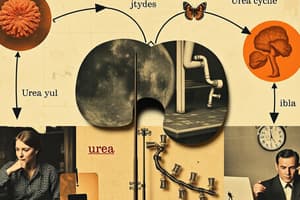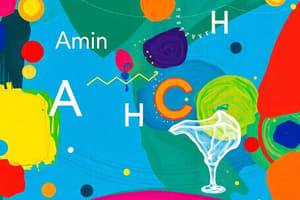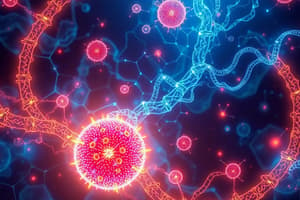Podcast
Questions and Answers
What is the primary function of aminotransferases in nitrogen metabolism?
What is the primary function of aminotransferases in nitrogen metabolism?
- To convert pyruvate into glucose
- To generate free amino acids from peptides
- To catalyze the transfer of amino groups between amino acids and alpha-ketoglutarate (correct)
- To initiate protein digestion in the stomach
Which of the following statements best describes the liver's role in amino acid metabolism?
Which of the following statements best describes the liver's role in amino acid metabolism?
- The liver absorbs amino acids first and determines their release into circulation. (correct)
- The liver synthesizes all zymogens necessary for protein digestion.
- The liver breaks down all proteins into amino acids.
- The liver is not involved in amino acid metabolism.
What is the main end product of the protein digestion process?
What is the main end product of the protein digestion process?
- Zymogens
- Peptides
- Free amino acids (correct)
- Dipeptides
How does trypsin participate in the activation of digestive enzymes?
How does trypsin participate in the activation of digestive enzymes?
What is the relationship between alpha-ketoglutarate and nitrogen metabolism?
What is the relationship between alpha-ketoglutarate and nitrogen metabolism?
Which of the following amino acids is formed from pyruvate and ammonia?
Which of the following amino acids is formed from pyruvate and ammonia?
What distinguishes endopeptidases from exopeptidases in protein digestion?
What distinguishes endopeptidases from exopeptidases in protein digestion?
Which amino acid is produced when glutamate combines with ammonia?
Which amino acid is produced when glutamate combines with ammonia?
What is the primary role of the Urea Cycle in nitrogen metabolism?
What is the primary role of the Urea Cycle in nitrogen metabolism?
Which of the following is NOT a source of amino acids contributing to the body's amino acid pool?
Which of the following is NOT a source of amino acids contributing to the body's amino acid pool?
How are essential amino acids defined in terms of nitrogen metabolism?
How are essential amino acids defined in terms of nitrogen metabolism?
What role does pepsin play in protein digestion?
What role does pepsin play in protein digestion?
What initiates the activation of pepsinogen in the stomach?
What initiates the activation of pepsinogen in the stomach?
Which hormone stimulates the secretion of pancreatic enzymes involved in protein digestion?
Which hormone stimulates the secretion of pancreatic enzymes involved in protein digestion?
What happens to the carbon skeletons of amino acids during nitrogen metabolism?
What happens to the carbon skeletons of amino acids during nitrogen metabolism?
In nitrogen metabolism, what does the term 'nitrogen balance' refer to?
In nitrogen metabolism, what does the term 'nitrogen balance' refer to?
What molecule is synthesized in the first step of the urea cycle?
What molecule is synthesized in the first step of the urea cycle?
Which enzyme is responsible for the second reaction in the urea cycle that produces citrulline?
Which enzyme is responsible for the second reaction in the urea cycle that produces citrulline?
What is the primary role of n-acetylglutamate in the urea cycle?
What is the primary role of n-acetylglutamate in the urea cycle?
Which substrate is combined with acetyl CoA and glutamate to form n-acetylglutamate?
Which substrate is combined with acetyl CoA and glutamate to form n-acetylglutamate?
What is released by arginase during the urea cycle?
What is released by arginase during the urea cycle?
Which intermediate of the urea cycle is also a common intermediate in the TCA cycle?
Which intermediate of the urea cycle is also a common intermediate in the TCA cycle?
What triggers an increase in urea cycle enzyme synthesis following a high protein meal?
What triggers an increase in urea cycle enzyme synthesis following a high protein meal?
Where do the initial reactions of the urea cycle occur?
Where do the initial reactions of the urea cycle occur?
Flashcards
Zymogen activation cascade
Zymogen activation cascade
A series of enzyme activations that begin with enteropeptidase activating trypsinogen, leading to the activation of other pancreatic enzymes like chymotrypsinogen.
Enteropeptidase
Enteropeptidase
An enzyme that activates trypsinogen, initiating the activation cascade of pancreatic digestive enzymes.
Trypsin
Trypsin
A pancreatic digestive enzyme activated from trypsinogen that further activates other zymogens.
Amino acid transfer
Amino acid transfer
Signup and view all the flashcards
Aminotransferase
Aminotransferase
Signup and view all the flashcards
Endopeptidase
Endopeptidase
Signup and view all the flashcards
Exopeptidase
Exopeptidase
Signup and view all the flashcards
Protein digestion end products
Protein digestion end products
Signup and view all the flashcards
Nitrogen Metabolism
Nitrogen Metabolism
Signup and view all the flashcards
Amino Acid Pool
Amino Acid Pool
Signup and view all the flashcards
Essential Amino Acids
Essential Amino Acids
Signup and view all the flashcards
Nitrogen Balance
Nitrogen Balance
Signup and view all the flashcards
Protein Digestion – Stomach
Protein Digestion – Stomach
Signup and view all the flashcards
Pepsin Zymogen
Pepsin Zymogen
Signup and view all the flashcards
Protein Digestion - Small Intestine
Protein Digestion - Small Intestine
Signup and view all the flashcards
Urea Cycle
Urea Cycle
Signup and view all the flashcards
Carbomyl Phosphate Synthetase I (CPS-I)
Carbomyl Phosphate Synthetase I (CPS-I)
Signup and view all the flashcards
Ornithine Transcarbamylase
Ornithine Transcarbamylase
Signup and view all the flashcards
Urea Cycle Intermediates
Urea Cycle Intermediates
Signup and view all the flashcards
Urea Synthesis Location
Urea Synthesis Location
Signup and view all the flashcards
N-acetylglutamate
N-acetylglutamate
Signup and view all the flashcards
Urea Cycle Regulation
Urea Cycle Regulation
Signup and view all the flashcards
Urea Excretion
Urea Excretion
Signup and view all the flashcards
Study Notes
Copyright Notice and Agreement
- Class materials are for exclusive student use (CUSOM, MSBS).
- Access and use conditions must be agreed to.
- Students who do not agree are prohibited from accessing or using materials.
- Students acknowledge faculty intellectual property rights.
- Distribution of class materials violates CUSOM copyright policy.
- Student privacy rights are acknowledged.
- Sharing materials with unauthorized parties is an honor code violation.
- All class materials are for course use only, as directed.
Urea Cycle
- Amino acids are added or removed for nitrogen balance.
- Protein digestion involves pepsinogen, pepsin, zymogen, cholecystokinin, secretin, enteropeptidase, trypsinogen, trypsin, chymotrypsinogen, chymotrypsin, endopeptidases, and exopeptidases.
- Amino acids are associated with specific carbon skeletons (alpha-ketoglutarate, pyruvate, oxaloacetate).
- Nitrogen transfer between carbon skeletons uses aminotransferases, glutamate dehydrogenase, glutamine synthetase, and glutaminase.
- The urea cycle purpose, regulation, and physiological alterations during defects are essential to understand.
- Liver and kidney roles in urea and ammonia production and elimination are vital.
Nitrogen Metabolism
- Nitrogen metabolism includes amino acid, protein, heme, and nucleotide metabolisms.
- Humans lack nitrogen storage forms, unlike glucose (glycogen) and lipids (TAGs, cholesterol).
Nitrogen Turnover
- Most nitrogen enters the body as amino acids.
- Contributions to the amino acid pool include dietary protein, protein turnover in the body, and synthesis of nonessential amino acids.
- Amino acids are removed from the pool for protein synthesis, synthesis of other compounds (nucleotides and heme), and use of amino acid carbon skeletons for other compounds (glucose, lipids, or energy).
Protein Digestion
- Protein must be broken down into amino acids or peptides for absorption.
- Stomach acid denatures proteins and kills microorganisms.
- Pepsin, an endopeptidase, is the main enzyme for protein digestion in the stomach.
- Pepsinogen, an inactive precursor, is converted to pepsin by the low pH in the stomach.
- Pepsin activates other pepsinogen molecules.
- Small intestine enzymes for protein digestion include pancreatic enzymes (trypsin, chymotrypsin, elastase, carboxypeptidase) and intestinal enzymes.
- Cholecystokinin and secretin stimulate pancreatic secretion.
Removal of Nitrogen and Transport
- Nitrogen transfer primarily involves the alpha-ketoglutarate skeleton.
- Aminotransferases catalyze transfer between amino acids and alpha-keto groups.
- Examples of aminotransferases like alanine aminotransferase (ALT) and aspartate aminotransferase (AST) are important in medicine as indicators of tissue damage.
- Glutamate dehydrogenase removes ammonia from glutamate, forming alpha-ketoglutarate.
- Glutamine synthetase adds ammonia to glutamate, forming glutamine.
- Glutaminase releases ammonia from glutamine.
- Removal of nitrogen from various tissues occurs through glutamine and alanine transport.
Urea Cycle
- Urea is the primary nitrogen excretion form.
- Urea cycle steps:
- Carbamoyl phosphate synthetase I (CPS-I) is the rate-limiting step, using CO2 and ammonia to create the required component.
- Ornithine transcarbamylase forms citrulline.
- Citrulline is then transported to the cytoplasm where its reactions continue in the urea cycle
- Enzymes involved in the urea cycle include aspartate transcarbamoylase, argininosuccinate synthetase, argininosuccinase, arginase.
- Regulation (activation) of CPS-I occurs via N-acetylglutamate for increased urea cycle function, usually with high levels of protein.
- Urea synthesized is released into the bloodstream and filtered by kidneys, excreted in urine.
- Defects in enzymes of the urea cycle (such as Orinithine transcarbamylase deficiency) lead to hyperammonemia.
Hyperammonemia
- Defects in urea cycle enzymes lead to hyperammonemia.
- Hyperammonemia is a severe condition related to inborn errors of metabolism.
- Understanding the impact of these genetic defects on metabolic pathways is vital for treatment approaches.
Studying That Suits You
Use AI to generate personalized quizzes and flashcards to suit your learning preferences.




